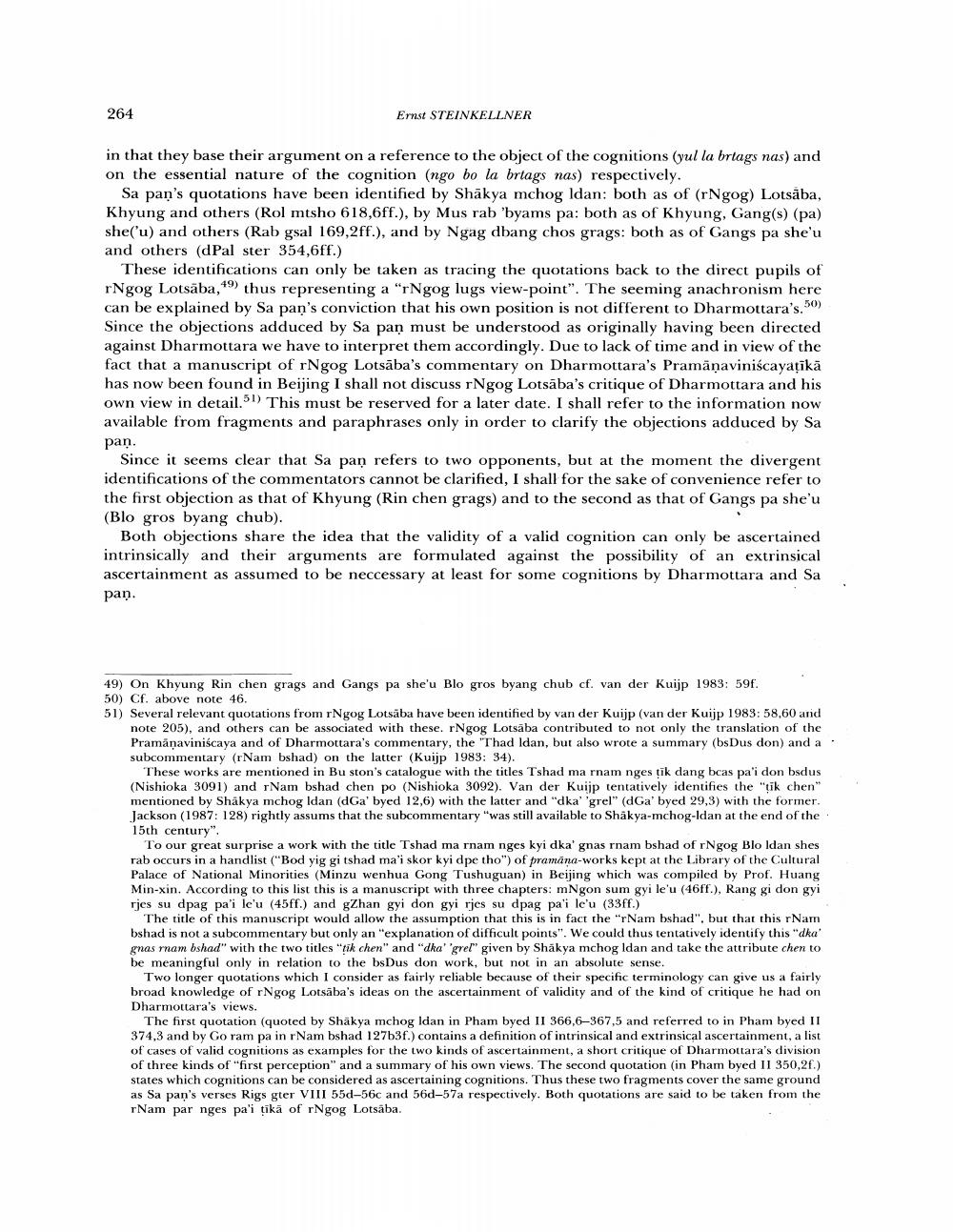________________
264
Ernst STEINKELLNER
in that they base their argument on a reference to the object of the cognitions (yul la brtags nas) and on the essential nature of the cognition (ngo bo la brtags nas) respectively.
Sa pan's quotations have been identified by Shākya mchog Idan: both as of (rNgog) Lotsāba, Khyung and others (Rol mtsho 618,6ff.), by Mus rab 'byams pa: both as of Khyung, Gang(s) (pa) she('u) and others (Rab gsal 169,2ff.), and by Ngag dbang chos grags: both as of Gangs pa she'u and others (dPal ster 354,6ff.)
These identifications can only be taken as tracing the quotations back to the direct pupils of rNgog Lotsāba,9) thus representing a "rNgog lugs view-point". The seeming anachronism here can be explained by Sa pan's conviction that his own position is not different to Dharmottara's.50) Since the objections adduced by Sa paņ must be understood as originally having been directed against Dharmottara we have to interpret them accordingly. Due to lack of time and in view of the fact that a manuscript of rNgog Lotsāba's commentary on Dharmottara's Pramāņaviniscayaţikā has now been found in Beijing I shall not discuss rNgog Lotsāba's critique of Dharmottara and his own view in detail.51) This must be reserved for a later date. I shall refer to the information now available from fragments and paraphrases only in order to clarify the objections adduced by Sa pan.
Since it seems clear that Sa pan refers to two opponents, but at the moment the divergent identifications of the commentators cannot be clarified, I shall for the sake of convenience refer to the first objection as that of Khyung (Rin chen grags) and to the second as that of Gangs pa she'u (Blo gros byang chub).
Both objections share the idea that the validity of a valid cognition can only be ascertained intrinsically and their arguments are formulated against the possibility of an extrinsical ascertainment as assumed to be neccessary at least for some cognitions by Dharmottara and Sa pan.
49) On Khyung Rin chen grags and Gangs pa she'u Blo gros byang chub cf. van der Kuijp 1983: 59f. 50) Cf. above note 46. 51) Several relevant quotations from rNgog Lotsāba have been identified by van der Kuijp (van der Kuijp 1983: 58,60 and
note 205), and others can be associated with these. rNgog Lotsāba contributed to not only the translation of the Pramāņaviniscaya and of Dharmottara's commentary, the "Thad Idan, but also wrote a summary (bs Dus don) and a subcommentary (rNam bshad) on the latter (Kuijp 1983: 34).
These works are mentioned in Bu ston's catalogue with the titles Tshad ma rnam nges tik dang bcas pa'i don bsdus (Nishioka 3091) and rNam bshad chen po (Nishioka 3092). Van der Kuijp tentatively identifies the "tik chen" mentioned by Shakya mchog Idan (dGa' byed 12,6) with the latter and "dka' 'grel" (dGa' byed 29,3) with the former. Jackson (1987: 128) rightly assums that the subcommentary "was still available to Shakya-mchog-Idan at the end of the 15th century".
To our great surprise a work with the title Tshad ma rnam nges kyi dka' gnas rnam bshad of rNgog Blo Idan shes rab occurs in a handlist ("Bod yig gi tshad ma'i skor kyi dpe tho") of pramāna-works kept at the Library of the Cultural Palace of National Minorities (Minzu wenhua Gong Tushuguan) in Beijing which was compiled by Prof. Huang Min-xin. According to this list this is a manuscript with three chapters: mNgon sum gyi le'u (46ff.), Rang gi don gyi rjes su dpag pa'i le'u (45ff.) and gZhan gyi don gyi rjes su dpag pa'i le'u (33ff.) The title of this manuscript would allow the assumption that this is in fact the "rNam bshad", but that this rNam
difficult points". We could thus tentatively identify this "dka' gnas rnam bshad" with the two titles "tik chen" and "dka' 'grel" given by Shakya mchog Idan and take the attribute chen to be meaningful only in relation to the bsDus don work, but not in an absolute sense.
Two longer quotations which I consider as fairly reliable because of their specific terminology can give us a fairly broad knowledge of rNgog Lotsāba's ideas on the ascertainment of validity and of the kind of critique he had on Dharmottara's views.
The first quotation (quoted by Shakya mchog Idan in Pham byed II 366,6–367,5 and referred to in Pham byed II 374,3 and by Go ram pa in rNam bshad 127b3f.) contains a definition of intrinsical and extrinsical ascertainment, a list of cases of valid cognitions as examples for the two kinds of ascertainment, a short critique of Dharmottara's division of three kinds of "first perception" and a summary of his own views. The second quotation in Pham byed II 350,28.) states which cognitions can be considered as ascertaining cognitions. Thus these two fragments cover the same ground as Sa pan's verses Rigs gter VIII 550-56c and 560-57a respectively. Both quotations are said to be taken from the rNam par nges pa'i tīkā of rNgog Lotsāba.




